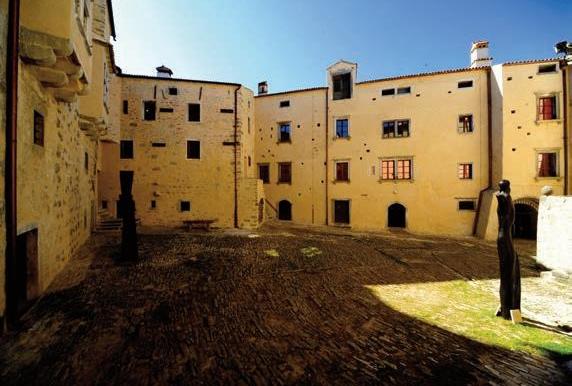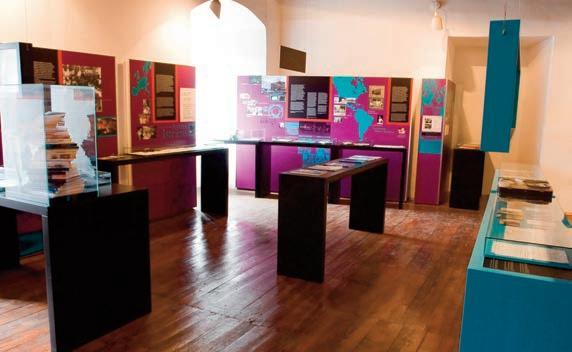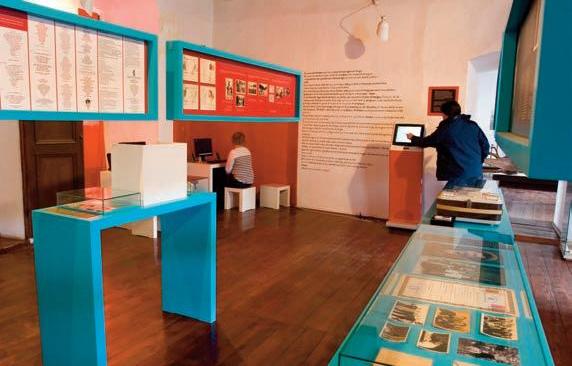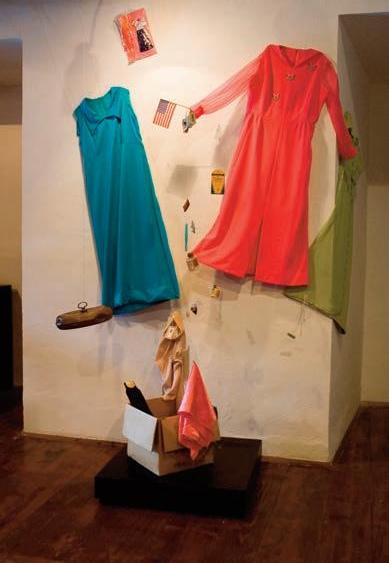
12 minute read
l Istrian emigration meets the museum: encouraging dialogue and understanding between ideologies
from Museum Ireland, Vol 24. Lynskey, M. (Ed.). Irish Museums Association, Dublin (2014).
by irishmuseums
Istrian emigration meets the museum: encouraging dialogue and understanding between ideologies
LIDIjA NIkOčEVIć
Advertisement
1. This article is based on a talk presented at the Irish Museums Association Annual Conference, Museums & Memory: Challenging Histories on 22nd February 2014, Waterford.
Introduction1
When mentioning Istria one has to keep in mind that this region is profoundly shaped by displacement throughout the 20th century. Therefore, to discuss Istrian emigration is to discuss in a great deal the Istrian history in the last century in general. The leading regionalist party in Istria today is stressing the idea of multiculturalism as one of the most important characteristics of the social culture in Istria. However, the quality of different nations and ethnic groups of the Istrian peninsula living together has varied and differed throughout centuries and in specific situations and places. Seen today as a quality that is a symbol of tolerance, multiculturalism (together with nationalistic ideologies that were tied to nations that have lived in Istria) was in the biggest part of the 20th century a reason for nationalistic struggles between two major groups of population – the Italian and Slavic which encompassed both Croatians and Slovenians (whose ethnic space is northern Istria) who were living in Istria. Italians were literate, urban; in most of the cases they were better off and they had developed different institutions – in short, they were the upper layer of society up until the end of the Second World War. In the same period, Croatians and Slovenians were mostly illiterate, rural, rather poor and lacking institutions. Since Austrian times (when Istria was a part of the Austro-Hungarian Monarchy) the animosities between these two groups were not exaggerated and/or kept under control thanks to the political compromises made by the Monarchy’s politicians, that time has often – even today – been recalled by most Istrians as a time of relative harmonious relations among all groups of the population.
The History of Istria
Besides the multicultural situation, the fact that Istria belonged to five different states (Austro-Hungarian Monarchy, Italy, Germany, yugoslavia and Croatia) in the last century made it difficult for the
Istrian population to identify with only one state and only one culture. This situation for most Istrians meant the interior displacement at certain periods as well thanks to political regimes that favoured specific nation(s) at a time. However, the emigration began at the beginning of the 20th century thanks to the poor economic situation in the district which increased in the 1920s. Leaving mostly for Argentina, Brazil and uSA, Istrians found various strategies to survive, – eg working in New york harbour or in the steel and mechanical engineering industry in Cleveland. At that time, in the period between the two world wars, Istria became a part of Italy. Italy’s orientation towards fascism gradually developed into an intolerance towards the Slavic population of Istria making life difficult or impossible for many Croats and Slovenians. Croatian schools were closed, family names and placenames were Italianized. The use of the Croatian or Slovene language in public was forbidden at certain times. Therefore many anti-Fascists left together with Slovenians, Croats (and Austrians). Most of them left for the then yugoslavia and remain scattered throughout that country. In zagreb (and to a certain degree in Belgrade), they formed an enclave, founded many clubs and developed a significant publishing activity.
After the Second World War Istria was joined to yugoslavia. This was accompanied with the huge euphoria of liberators and the majority of local Slavic population. Those liberators meant occupants for Italians in Istria, since they brought nationalization of property and prosecution and punishment of political enemies and bourgeoisie. All this represented another kind of a totalitarian regime based on the communist ideology and this was the reason why many Italians started to think about leaving Istria. The murder of hundreds of Italians in foibe (pits in the Carsick terrain) instilled a mass fear – so intense that foibe have remained a symbol of the exodus of Istrian Italians until today. It is believed that more than 200,000 people left Istria and Dalmatia because of the change of in the system and because of the murders, threats, consternation and fear, but also due to the propaganda from both the yugoslav and Italian sides. However, this number is the object of constant negotiation as are many facts tied to ‘il grande esodo’ (the big exodus). The leaving of esuli resulted in many ghost-towns in Istria. Abandoned houses in many Istrian small towns are evidence of the effects of the post Second World War exodus. However, when they
came to ‘madre patria’, Italy, they were seen as remains of the old regime, which Italy at that time wanted to distance itself from. About one third of all Istrian refugees settled down in Trieste and this is one of the reasons why Trieste is today recognized as ‘The capital of the exile’ (Il capitale del esodo). Many of the refugees spent several years in refugee camps throughout Italy. Nowadays, this theme is a hot political issue, mostly actualized by right-oriented parties in Italy. They support esuli in attempts to gain back their lost property in Istria, but also in their public activities: exhibitions, book fairs, etc. Istrians in Italy are organized into societies called ‘families’ (eg Famiglia Dignanese, Famiglia Pisinota, Famiglia Parentina etc). Members of those communities reconstruct various aspects of traditional Istrian life (Church patron’s days, celebrations and local festivals) as well as new traditions of commemorating the violent actions of ‘Slavic barbarity’ tied to foibe and the exodus in general. In general, they don’t want to be seen as Istrian emigrants, since this attribution is too euphemistic for them – they think of themselves as refugees, as victims of ethnic cleansing. Mostly they consider that genuine Istrians (Istriani veraci) are to be found only outside Istria’s territorial confines.
Museum of the Istrian and Dalmatian Civilization
Fig 1. The Inner Courtyard of the Ethnographic Museum of Istria. Pazin 2012 (2) However, not all Istrians are involved in these group activities and some of them even criticized the concept of the ‘Museum of the Istrian and Dalmatian Civilization’ that opened in Trieste a couple of years ago. The museum’s collections are based on material that esuli took from their homes and which had to be left in the warehouses in the Trieste harbour. The Director of the museum said: ‘there is no better place where we can learn about ourselves than in this museum. We are people that have lost our land. All we have is our history, and if this is all we have, we either remember it or forget it. If we forget it, then
there is no point in our existence as a community, or as individual identities’.
Post-war period
As a result of a similar social and political atmosphere coupled with economic reasons, many other Istrians of Croatian origin were thinking about leaving the peninsula in the post-war period and up until the 1970s. They were often young people including young couples. After leaving Istria (mostly illegally) and after spending some months (and years) in refugee camps in Italy, they wanted to seek their fortune in ‘promised lands’ such as Australia and uSA. In New york they formed two clubs the ‘Istrian Sport Club’ and the ‘Rudar Sport Club’ and on a more general level the ‘united Istrians of the World’. All of these societies often organize various festivities and occasions that bring Istrians together. In New york, they are known as restaurant staff and keepers (such as Lidia Bastianich), who market themselves as restaurants of Italian cuisine, thinking that the notion of Istrian Cuisine (being unknown as such) wouldn’t be that attractive. Individually, they visit Istria on a regular basis and still have strong ties with their former homeland. Their homes in the uSA are full of memorabilia and souvenirs from Istria. These symbols of Istrianity are tied to periods of their lives in Istria in their youth before they left. Contrary to many Italian Istrians who live in Italy and still think of barbarians who took over their country, they have kept romantic visions about Istria remembering it as unchanged. This kind of idealized Istrianity generally does not exist anymore. Many transformations have brought a new population and new cultural influences. Their vision of Istrian culture can be compared with the ‘old school’ of ethnographic material present in museum exhibitions, which modern ethnography has distanced itself from for many years. They call themselves ‘Istrians’ clearly limiting and demarcating their ethnicity from Croatian and Italian nationalities. Therefore they don’t see themselves as a part of the Croatian or Italian Diaspora nor do those countries perceive them as such.
Here we touch one of the problems that the exhibition ‘Suitcases and Destinies’ in the Ethnographic museum of Istria in Pazin about Istrian Diaspora in the 20th century was faced with – the way this

batch of Istrian emigrants has been treated by national authorities including their administration for Croatian or Italian diaspora. From the Croatian side, since Istrians haven’t identified with any nationality, they were regarded as non-Croats and haven’t been included in national programs or projects tied to Croatian emigrants. Another political issue was the fact that those Istrians who live in Italy have been – in Croatia and even more so in yugoslavia – strongly associated and identified with right wing politics. In this way, the ideology has dominated and absorbed human experience of exiled Istrians and their right to be heard and understood outside of political frames and agendas.
No books have been written in Croatia about these issues. It is not included in school programs and no exhibitions on this topic had been made before we did ours. One also has to keep in mind the fact that there are still two or three national histories (Italian, Croatian, Slovenian) that each have their own interpretation of history. As a Regional museum, luckily we could get funding from the Regional Department of Culture but certainly not from the National Ministry of Culture. The regional authorities were aware of how important this theme was not only for the Istrian of the past but also for today’s Istrian reality. They recognized that we wanted to show a new, nonnation oriented perspective of not only the Istrian Diaspora but of Istrian history in general.
As curators, we wished to show what impact totalitarian regimes had on emigration and displacement of people and to present the different voices of various emigrants and their destinies without judgement. Luckily, being ethnographers and anthropologists allowed us not to interpret history to a larger extent but to offer another ‘truth’ as we see it and to focus on testimonies to show that what people really experienced. On a practical level, achieving this goal hasn’t been that easy. When we asked esuli living in Italy to help us with some material (both objects and life stories) they told us that
Fig 2. The section of the exhibition on Istrian Emigration Suitcases and Destinies about Associations and Clubs of emigrated Istrians in the world. Pazin, 2012.
we should ask the Institute for the Istrian Culture in Trieste (that established the Museum of the Istrian and Dalmatian Civilization) about that, since they had already told them everything. In this way, they were redirecting our questions to an institution – actually not wanting direct contact with the researcher. Their life stories have become institutionalized. The most helpful informants and collaborators we found were individuals that hadn’t shared their stories yet or didn’t feel obliged to the above named institutions or associations.
The exhibition was organized into various chapters, such as Similarities and differences, Political systems and emigration, ADDIO (Farewell), Where does this ship sail to, Exodus: Option holders and displaced persons, Long-lasting impermanence: refugee camps and stations, New life, New home, Work, ‘Northern Istrian’ cuisine, Letters and packages, Associations, Families & club and Memories & Mementos. These themes or phenomena were common to most emigrants in the 20th Century no matter what their reason for leaving Istria. A much more personalized, individual part of the exhibition was the presentation of twelve people’s destinies representing emigrants of different age and genders with different motivations for leaving Istria. In this central part, people spoke for themselves, which means that we exhibited objects, photos and quotations which they had shared with us and allowed us to use. The objects that had belonged to them and that we exhibited illustrated their understanding and emotions regarding the ‘old homeland’ and their memories and interpretations. Examples of objects are a ticket from home to Italy, banal souvenirs bought in Istria and sometimes, for example, a decorative mat made from the old woven sheet (taken from the old home) whose parts were recently connected by the new home-made lace in order to form a mat. Their own voices could be heard, the music they played or recorded, together with many films on the theme of the Istrian emigration. It seems that the combination of audio-visual techniques and some texts, which we use in museums, was a communicative and effective one in this case.

Fig 3. The second hall of the exhibition. Pazin 2012.
Fig 4. Package with contents as it arrived from the US to Istria (sent by an emigrated Istrian to his familly in Istria) during the 1960s. Pazin 2012. In many Istrian families, there were family members who left by illegally escaping through the border. Since not only these individuals, but the whole family would be suspected and possibly punished by the then yugoslav authorities. It would remain almost forbidden to talk about the theme of emigration in public in these families. Stories of this type might remain unspoken for a long time. During visits while the exhibition ‘Suitcases and Destinies’ was shown, some visitors were reminded of family members who fled and began talking about them to people in their company. That meant that this exhibition helped them to contextualize their isolated experience within a bigger frame, a larger story that suddenly was interpreted within a museum and therefore gained an ‘acknowledged’ position within Istrian history and culture. The same goes for the Italians that left, who have often identified with certain ideologies and political contexts. Some especially illuminating and moving occasions included various planned or random meetings of various emigrants at the exhibition where people exchanged their experiences – and addresses. For children and young people who live in Istria, pedagogical programs enabled them to understand a phenomenon that they haven’t learned about at school and also helped them to identify on different levels with migration and transmigration.

Conclusion
Seeing this project within the frame of a possible reconciliation between members of different ideologies (both within and outside Istria) one can ask the question who would attempt reconciliation here: each group identified themselves with the population that lives in Istria today. However, as with many contemporary themes that have many contesting interpretations, just presenting a problem and raising some questions is certainly a way to start dealing with ‘sensitive matters’ on our history and culture.
Lidija Nikočević is Director of the Ethnographic Museum of Istria, Pazin, Croatia






